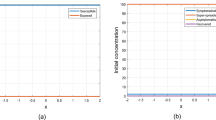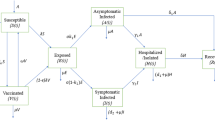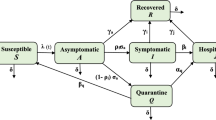Abstract
Epidemic diseases are well known to be fatal and cause great loss worldwide—economically, socially and mentally. Even after around nine months, since the Coronavirus Disease 2019 (COVID-19) began to spread, people are getting infected all over the world. This is one of the areas where human medical advancements fail because by the time the disease is identified and its treatment is figured out, most of the population is already exposed to it. In such cases, it becomes easier to take steps if the dynamics of the disease and its sensitivity to various factors is known. This chapter deals with developing a mathematical model for the spread of Coronavirus disease, by employing a number of parameters that affect its spread. A compartmental modelling approach using ordinary differential equation has been used to formulate the set of equations that describe the model. We have used the next generation matrix method to find the basic reproduction number of the system and proved that the system is locally asymptotically stable at the disease-free equilibrium for \(R_0<1\). Stability and existence of endemic equilibrium have been discussed, followed by sensitivity of infective classes to parameters like proportion of vaccinated individuals and precautionary measures like social distancing. It is expected that after the vaccine is developed and is available to use, as the proportion of vaccinated individuals will increase, the infection will decrease in the population which can gradually lead to herd immunity. Since, the vaccine is still under development, non-intervention measures play a major role in coping with the disease. The disease generally transmits when the water droplets from an infected individuals’ mouth or nose are inhaled by a healthy individual. The best measures that should be adopted are social distancing, washing one’s hands frequently, and covering one’s mouth with mask, quarantine and lockdowns. Thus, as more and more precautionary measures are taken, it would gradually reduce the infection which has also been proved numerically by the sensitivity analysis of ‘w’ in our dynamical analysis.
Access this chapter
Tax calculation will be finalised at checkout
Purchases are for personal use only
Similar content being viewed by others
References
Ochoche, J. M., & Gweryina, R. I. (2014). A mathematical model of Measels with vaccination and two phases of infectiousness. IOSR Journal of Mathematics, 10, 95–105. https://doi.org/10.9790/5728-101495105.
Senapati, A., Rana, S., Das, T., & Chattopadhyay, J. (2020). Impact of intervention on the spread of COVID-19 in India: A model based study. https://arxiv.org/abs/2004.04950.
Paul, A., Chatterjee, S., & Bairagi, N. (2020). Prediction on COVID-19 epidemic for different countries:Focusing on South Asia under various precautionary measures. https://doi.org/10.1101/2020.04.08.20055095.
Ngonghala, C. N., Iboi, E., Eikenberry, S., Scoth, M., MacIntyre, R. C., Bonds, M.H., & Gumel, A. B. (2020). Mathematical assessment of the impact of non-pharmaceutical interventions on curtailing the 2019 novel Coronavirus, Mathematical Bioscienes. https://doi.org/10.1016/j.mbs.2020.108364.
Aguilar, J. B., Faust, J. S., Westafer, L. M., & Gutierrez, J. B. (2020). Investigating the impact of asymptomatic carriers on COVID-19 transmission. https://doi.org/10.1101/2020.03.18.20037994.
Chang, X., Liu, M., Jin, Z., & Wang, J. (2020). Studying on the impact of media coverage on the spread of COVID-19 in Hubei Province, China. Mathematical Biosciences and Engineering, 17(4), 3147–3159. http://dx.doi.org/10.3934/mbe.2020178.
Kassa, S. M., Njagarah, H. J. B., & Terefe, Y. A. (2020). Analysis of the mitigation strategies for COVID-19: from mathematical modelling perspective. Chaos, Solitons and Fractals, 138, 1–16, Article ID 109968. https://doi.org/10.1016/j.chaos.2020.109968.
Shah, N. H., Suthar, A. H., & Jayswal, E. N. (2020). Control strategies to curtail transmission of COVID-19. International Journal of Mathematics and Mathematical Sciences, 2020, 1–12, Article ID 2649514. https://doi.org/10.1155/2020/2649514.
Zaman, G., Kang, Y. H., & Jung, I. H. (2009). Optimal treatment of an SIR epidemic model with delay. BioSystems, 98(1), 43–50. https://doi.org/10.1016/j.biosystems.2009.05.006.
Zaman, G., Kang, Y. H., Cho, G., & Jung, I. H. (2017). Optimal strategy of vaccination and treatment in an SIR epidemic model. Mathematics and Computers in Simulation, 136, 63–77. https://doi.org/10.1016/j.matcom.2016.11.010.
Samsuzzoha, M., Singh, M., & Lucy, D. (2013). Uncertainty and sensitivity analysis of the basic reproduction number of a vaccinated epidemic model of influenza. Applied Mathematical Modelling, 37(3), 903–915. https://doi.org/10.1016/j.apm.2012.03.029
World Health Organization (WHO) website, COVID-19 information: https://www.who.int/emergencies/diseases/novel-coronavirus-2019/advice-for-public.
World Health Organization (WHO) website, Small-pox information: https://www.who.int/csr/disease/smallpox/vaccines/en/.
Hang, J., Yang, Z., Pawelek, K. A., & Liu, S. (2019). Optimal control strategies for a two-group epidemic model with vaccination-resource constraints. Applied Mathematics and Computation, 371, Article ID 124956. https://doi.org/10.1016/j.amc.2019.124956.
Chatterjee, A. N., Saha, S., Roy, P. K., Basir, F. A., Khailov, E., & Grigorieva, E. (2020). Insight of COVID-19/ SARS-CoV-2 and its Probable Treatment—A Mathematical Approach. https://doi.org/10.21203/rs.3.rs-34519/v1.
Kaustuv Chatterjee, Kaushik Chatterjee, A. Kumar, S. Shankar, Healthcare impact of COVID-19 epidemic in India: A stochastic mathematical model, Medical Journal Armed Forces India, vol. 76(2), pp. 147-155, 2020. https://doi.org/10.1016/j.mjafi.2020.03.022
Cintra, P. H. P., Citeli, M. F., & Fontinele, F. N. (2020). Mathematical Models for Describing and Predicting The COVID-19 Pandemic Crisis. https://arxiv.org/abs/2006.02507.
A.M. Mishra, S.D. Purohit, K.M. Owolabi, Y.D. Sharma, A nonlinear epidemiological model considering asymptotic and quarantine classes for SARS CoV-2 virus, Chaos, Solitons and Fractals, vol. 138, Article ID 109953, pp. 1-10, 2020. https://doi.org/10.1016/j.chaos.2020.109953
Author information
Authors and Affiliations
Corresponding author
Editor information
Editors and Affiliations
Rights and permissions
Copyright information
© 2021 The Author(s), under exclusive license to Springer Nature Singapore Pte Ltd.
About this paper
Cite this paper
Bahri, Y., Bhatia, S.K., Chauhan, S., Mittal, M. (2021). Compartmental Modelling Approach for Accessing the Role of Non-Pharmaceutical Measures in the Spread of COVID-19. In: Shah, N.H., Mittal, M. (eds) Mathematical Analysis for Transmission of COVID-19. Mathematical Engineering. Springer, Singapore. https://doi.org/10.1007/978-981-33-6264-2_13
Download citation
DOI: https://doi.org/10.1007/978-981-33-6264-2_13
Published:
Publisher Name: Springer, Singapore
Print ISBN: 978-981-33-6263-5
Online ISBN: 978-981-33-6264-2
eBook Packages: EngineeringEngineering (R0)




